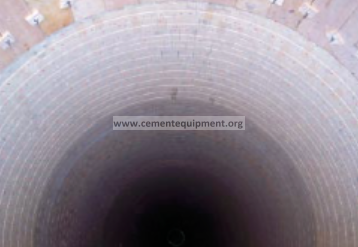Contents
Everything you need to know about Refractories in Cement Manufacturing
[wpecpp name=”package” price=”75″ align=”center”]
by Ricardo Araujo Mosci*
Portland cement manufacturing is an energy intensive operation that involves pyroprocessing of raw materials, referred to as the kiln feed, at extremely high temperatures in rotary kilns. The kiln feed primarily consists of limestone with some additions of clay, sand, and iron oxide that chemi-cally interact to form cement clinker. The kiln feed is alkaline in nature; however, the raw materials often contain species that can generate corrosive reactants in the form of solids as well as gases. In a dynamic rotary kiln where these reactions occur at temperatures between 1250°C to 1450°C, a refractory lining that can withstand high temperatures, alkalinity, and corrosive conditions is absolutely essential. Refractory requirements for wet and dry kiln processes, and for kilns with cyclone preheaters and precalciners, differ significantly. In all situations, the refractories must have good hot strength, resistance to abrasion, compatible chemical composition, and sound thermal characteristics. This chapter discusses the importance of refractories, their types, and applications in cement manufacturing. A cement rotary kiln with refractory lining is shown in Figure 3.7.1.
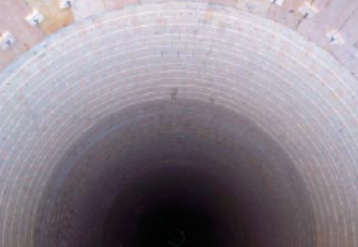
Figure 3.7.1. Rotary kiln containing refractory lining.
ROLE OF REFRACTORIES
Refractories are ceramic materials capable of withstanding elevated temperatures without signifi-cant deterioration. The role of refractories in cement kilns is multiple:
1. To protect the steel shell against heat Material and gas temperature inside the rotary kiln surpass the maximum work-ing temperature recommended for carbon steel. Without refractories the kiln shell would be destroyed by heat. As a result, as soon as the refractory lining fails, the kiln must be shut down for lining repair. The overheated areas on the kiln shell are commonly known as “hot spots” or “red spots.” Figure 3.7.2 illustrates a refractory failure that created a red spot on the shell.
2. To protect the kiln shell against abrasion – Cement clinker is very abrasive and without refrac-tories the steel shell would be damaged by abrasion.
3. To minimize heat loss through the kiln shell – Part of the heat supplied to the kiln system is lost as radiation through the steel shell. Refractories reduce heat loss because of their relatively low thermal conductivity.
4. To control the flow of material through the kiln – The kiln load travels under the combined action of kiln rotation and slope. Cam linings, dams, tumblers, and trefoils in the kiln oppose material flow allowing some control of material residence time.
5. To promote heat transfer to the kiln load – Tumblers, trefoils, and profiled linings induce material tumbling and mixing, which in turn promote heat transfer from gas to solids, from refractory to load, and within the load itself through agitation and surface renewal.
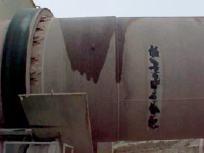
Figure 3.7.2. Red spots on the kiln shell.
TYPES OF REFRACTORIES FOR CEMENT KILNS
Refractories used in the kiln, cooler, and preheater are supplied either as pressed and fired brick, unshaped as monolithic products, or in pre-cast, pre-fired shapes. The rotary kiln is almost entirely lined with bricks, while the preheater, cooler, and gas ducts are usually lined with castables, plastics, or pre-cast shapes held in place by metal or ceramic anchors attached to the shell.
Bricks are classified in four major groups according to their composition: basic, high alumina, fire-clay, and special materials.
Basic Brick
Basic bricks have magnesia or dolomite as their major component, and a secondary mineral such as alumina, zircon, or spinel as a minor component. In most products the major component concentration varies between 60% and 95% by mass.
Natural sources of magnesia or dolomite of refractory quality are found in very few countries around the world. Most of the magnesia used in cement kiln brick comes from seawater or brine deposits. These are called synthetic magnesia or periclase sinters.
Magnesia alone is not used in kiln brick manufacture because of its poor thermal cycling proper-ties. For this reason, magnesia is blended with a secondary mineral before it is pressed and fired into bricks. The secondary mineral confers thermal shock properties or modified chemical proper-ties to the brick.
Chromium ores were widely used as secondary minerals in magnesia brick, but disposal problems caused by hexavalent chromium rendered these products an unattractive option in most countries. As a result, magnesia-chromium products were replaced with magnesia-alumina spinel products. Although magnesia-alumina spinel products do not present the excellent coatability of their pre-decessors, their thermal spalling resistance and alkali resistance far exceed those of chromium-containing products. Magnesia-spinel products also resist reducing conditions better than magnesia-chromium products.
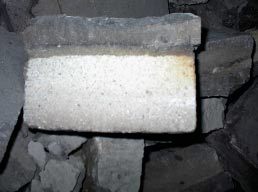
Figure 3.7.3.Overheated magnesia-spinel brick.
The magnesia-alumina spinel content in commercial bricks varies from 3% to 18% by mass. Higher magnesia products are usually more refractory but have higher thermal conductivity than lower magnesia products of similar porosity. Higher spinel bricks are more susceptible to chemical attack and fluxing than lower spinel bricks, but they exhibit better coatability and higher resistance to thermal spalling. Figure 3.7.3 depicts a fluxed magnesia spinel brick. The spinel itself can be sintered or fused, causing major differences in brick price and performance. Fused oxides are less reactive and less expensive than sintered oxides. It becomes clear from the previous facts that refractories cannot be compared only on the basis of their chemical or physical composition.
In order to improve the coatability of magnesia-spinel products, some manufacturers in Japan and Europe replace the magnesia-alumina spinel with iron-alumina spinel in different forms and concentrations. Iron oxides and spinels have been extensively used for this purpose. Trials were also run with oxides of manganese.
Another important member of the basic brick group is dolomite brick. Due to their compatibility with clinker minerals, dolomite bricks have good affinity for coating, making them an excellent choice for burning zone applications. Most dolomite bricks receive additions of zirconia or other secondary minerals to improve their thermal shock properties and also to delay brick infiltration with clinker melt and alkali salts. Some modern dolomite bricks include additions of magnesia, while others include additions of pitch or tar to decrease brick permeability and reduce its suscep-tibility to chemical attack. Dolomite products offer the lowest direct cost among all basic brick, but their application has been confined mostly to the burning zone where the clinker coating is more stable. The most adverse property of dolomite products is their risk of hydration, requiring special care in packaging, handling, and storage. For this reason dolomite products are usually confined to areas not too far from the manufacturing plant. Thanks to special vacuum packaging and brick treatment, the shelf life of dolomite products has increased considerably in recent years.
High-Alumina Bricks
High-alumina products used in cement kilns vary in alumina content from 50% to 85% by mass. Depending on the type of raw material used in their manufacture, high-alumina products of the same class present wide differences in properties and cost. To assume that all 70% alumina bricks are just commodities is a risky generalization. For instance, a mullite-based product presents greater thermal shock resistance than its bauxite counterpart. Similarly, a 60% andalusite brick resists alkali attack much better than its 60% bauxite equivalent.
Higher alumina products, such as 80% or 85% are sometimes used in the discharge zone of the kiln because of their superior mechanical strength and abrasion resistance. These bricks sometimes contain 1% to 3% phosphorus pentoxide to improve their hot strength and abrasion resistance. Phosphate additions have a tremendous impact on the stress-strain behavior of the product. Some phosphate-bonded bricks, as they are called, are oven-cured rather than fired at high temperatures. These products present better dimensional tolerances than their fired equivalents and are called chemically-bonded brick, as opposed to clay-bonded or ceramic-bonded.
In the calcining zone of the kiln, 70% alumina is the preferred choice unless alkali attack is so severe that a lower alumina product is required. As a general rule, the resistance to alkali attack increases as the alumina content decreases.
Fireclay Bricks
According to their alumina content, refractoriness, and porosity, fireclay products are classified as high duty, super duty and semi-silica. Although widely used in the upper part of the calcining zone in the past, high-duty and super-duty bricks are gradually being replaced by high-alumina and semi-silica products. One of the reasons is the difficulty of keeping fireclay brick tolerances within acceptable limits. Another reason is loss of strength at higher operating temperatures. During kiln upsets, fireclay products tend to react with the kiln load, leading to abrupt lining failure.
Semi-insulating products, although very low in mechanical strength, have the unique ability to react with alkali vapors in the kiln to form a thin glaze that protects it from abrasion and chemical attack. Their low thermal conductivity significantly reduces kiln shell temperature, a major advan-tage over tires. For best performance, these lightweight products must be installed with mortar. When selecting a semi-insulating product, attention must be paid to its thermal expansion proper-ties. Some products shrink at temperatures above 1000°C, a great risk in precalcining kilns, for instance.
Insulating bricks form a unique class of products. They are used only as backup linings for denser products in the preheater, cooler, and tertiary air duct. They lack the mechanical strength and refractoriness necessary to be used directly as the work lining.
Carbide and Zircon Bricks
In very special situations, zircon and silicon carbide bricks are used in the kiln with the purpose of minimizing ring formation in the calcining zone. Zircon bricks react with the clinker liquid phase when installed too close to the burning zone. Similarly, silicon carbide bricks promptly react with oxygen at high temperatures, especially in the presence of alkali or steam. Moreover, silicon carbide products have high thermal conductivity and low thermal expansion, making it difficult to get a tight lining in service. These disadvantages restrict the use of carbide and zircon brick to the calcining zone of the kiln.
REFRACTORY CLASSES
According to their shape, refractories are classified as:
Pressed and fired products: This class includes bricks, tiles, and blocks. Bricks are preferably used in uniform sections such as the kiln, cylindrical vessels in the preheater, and straight walls in the kiln hood and cooler. Special pressed shapes such as tiles and large blocks have been replaced with more cost-effective castable alternatives.
Monolithic products: This class includes castables, plastic, gunning mixes, shotcrete, and mortars. Monolithic products are used in complex areas such as ducts, ceilings, and curved surfaces. These products require efficient anchoring systems for good performance. Although faster to install than brick, monolithic products require careful curing and dryout before being put into service.
Specialties: This class includes calcium silicate boards, ceramic fibers, and mineral wool. These insulating materials are used as backup linings, usually not thicker than 125 mm. In temperatures above 1100°C, fiber insulators do not have sufficient stability to be used. In these applications they are replaced with insulating firebrick or castables.
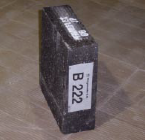
Figure 3.7.4. A typical magnesia-spinel wedge.
Table 3.7.1. VDZ Shape System, B Series, Without Cardboard Spacers
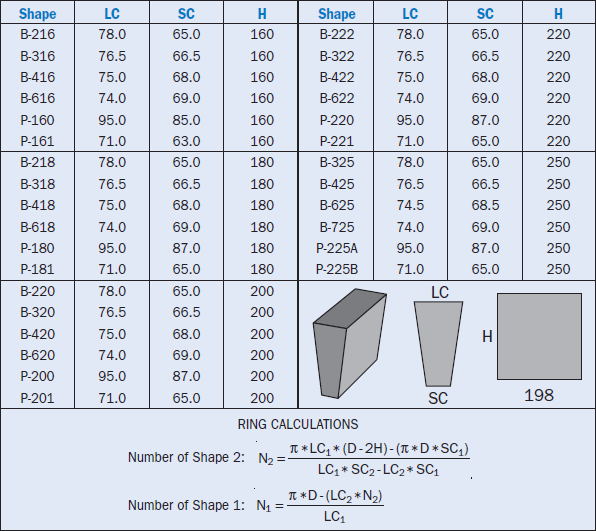
Table 3.7.2. ISO Shape System, Without Cardboard Spacers
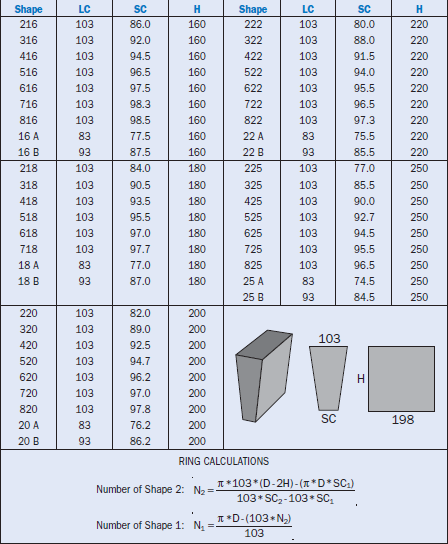
Table 3.7.3. Rotary Kiln Wedges and Arches
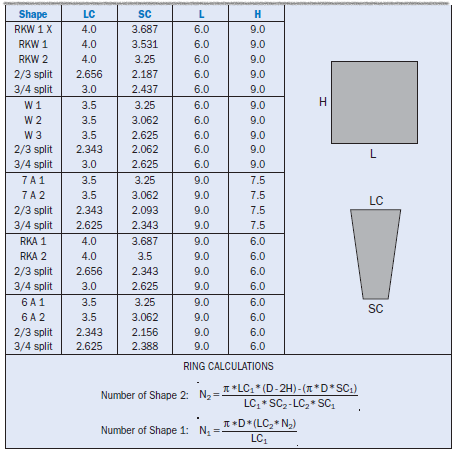
Table 3.7.4. Rotary Kiln Blocks

The one-shape family of bricks includes: 1) RKA, rotary kiln arches with 152-mm and 190-mm (6-in. and 71⁄2-in.) lining thickness, 2) RKW, rotary kiln wedges with 229-mm (9-in.) lining thick-ness, 3) RKB, rotary kiln blocks with 152-mm and 229-mm (6-in. and 9-in.) lining thickness.
The two-shape family of bricks includes: 1) VDZ shapes with160-mm, 180-mm, 200-mm, 220-mm, and 250-mm lining thickness, 2) ISO shapes (160-mm, 180-mm, 200-mm, 220-mm, 250-mm lining thickness, 3) Arch combinations with 152-mm and 190-mm (6-in. and 71⁄2-in.) lining thick-ness, and 4) Wedge combinations with 229-mm (9-in.) lining thickness.
This multiplicity of shapes is unnecessary and increases manufacturing and inventory costs considerably. The reason is the high cost of dies and tools, coupled with press set-up time, which delays production at the brick plant.
Opinions on which shape is best for a given kiln differ considerably from plant to plant and from person to person within the same plant in a quite subjective way.
Two-shape brick systems or brick combinations fit the kiln shell better than single shape systems be-cause kiln shells are not perfectly circular. By changing the ratio of the brick combination, the mason can line over imperfections without any major problem. However, when using one-shape brick over distorted areas, the mason has to shim the brick with steel plates, thus adding unnecessary stress to the lining. The claim that one-shape brick lines faster than a two-shape combination is questionable and lining performance should never be sacrificed at the expense of speed of installation.
Whenever choosing a brick shape system, some practical rules apply:
1. Basic brick usually expands more than high-alumina brick, thus requiring a larger number of joints per ring. As a consequence, small shapes such as VDZ, RKA, and RKW are more suitable for basic brick than large shapes.
2. Larger kilns require bricks with more taper such as ISO and RKB.
3. At kiln tires, where shell ovality is high, smaller shapes should be used because they generate more flexible linings, with a larger number of radial joints.
4. Against brick retainers, larger shapes should be used because they offer less chance for lining movement against the steel bar.
5. Smaller bricks are less stressful on the masons than the heavier ISO or RKB bricks. This factor is particularly important for crews working on 12-hour shifts.
One last point to consider when choosing a brick shape is the lining thickness. There is no proven correlation between lining thick-ness and performance. Sometimes a 160-mm lining lasts twice as long as a 220-mm lining in a given kiln for the simple reason that the radial stress that crushes the brick increases with the lining thickness. The ideal initial lining thickness for any kiln is the minimum thickness necessary to reach acceptable shell temperatures. Figure 3.7.5 shows a special shape designed to reduce kiln shell temperature.
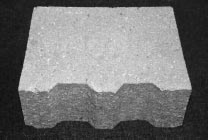
Figure 3.7.5. Special brick design to reduce shell temperature.
REFRACTORY PROPERTIES OF PRACTICAL IMPORTANCE
Refractory properties are controlled through standard tests performed by specialized laboratories. Some of the simpler tests can be performed at the consumer plant, but high temperature and some physical properties require high cost specialized equipment and trained people for tests to be prop-erly performed. Manufacturer data sheets include some of these properties but not necessarily the most important ones for cement kiln application.
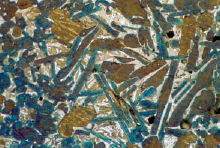
Figure 3.7.6. Micrograph of coating showing differ-ent crystal species, sizes, and orientations.
Other properties being constant, brick coatability decreases in the following order:
dolomite, magnesia-chrome, magnesia-alumina spinel, alumina, zirconia, silicon carbide.
Brick coatability is also affected by the degree of mineral impurities contained in the brick. For instance, a magnesia-spinel brick containing larger amounts of iron, alumina, silica, and lime coats better than a similar brick made with high purity raw materials. Some brick manufacturers add iron to their brick in order to promote coating formation.
Excessive coating formation is as harmful to the lining as no coating. High coatability materials are sometimes deeply infiltrated with clinker minerals. During kiln upsets when the heavy coating falls, it carries with it considerable amounts of brick. Under heavy coating, less permeable products with lower chemical affinity for coating should be employed.
Permeability
Permeability is a measure of the brick resistance to infiltration with gases and liquids. For the same service conditions, high-permeability products become more deeply infiltrated with liquids than low-permeability products. The infiltrates can react with the brick components or just condense inside the brick. During kiln shutdown or upon coating loss, the infiltrated brick spalls off. Permeability becomes critically important when the concentration of alkali and sulfur in the raw materials and fuels is high, particularly when burning waste-derived fuels in the burning zone.
Thermal Conductivity
Thermal conductivity is a function of material composition and manufacturing. For a given composition, a better pressed, less permeable product has higher thermal conductivity than a less pressed, more porous product. In the absence of coating, magnesia-spinel products have higher thermal conductivity than their magnesia-chrome and alumina counterparts. Shell temperatures of 400°C and higher are not uncommon in the upper transition zone of precalcining kilns, even with a new lining. Artificial ways to reduce the thermal conductivity of a basic brick, such as air gaps or pockets filled with ceramic fiber, present two adverse consequences: they increase the depth of brick infiltration with volatiles, and they promote kiln shell corrosion behind the lining.
The use of a two-component lining such as a dense brick installed over an insulating brick is not used in the kiln for the previous reasons and also because of the mechanical instability of the lining.
Abrasion Resistance
Refractory abrasion occurs mostly past the burning zone toward the cooler, where clinker is already formed and the lining has no coating. The burner pipe lining, the kiln discharge zone, the nosering, the cooler bull nose, and curbs are the most affected areas.
Abrasion resistance is measured in the laboratory, and test results correlate well with kiln applica-tions. The test consists of blasting a pre-measured piece of refractory with a granular abrasive under controlled conditions and calculating the volume loss afterwards.
Reversible Thermal Expansion
Brick thermal expansion is important because it governs the mechanical stability of the lining in service. Basic brick usually expands more than alumina brick and fireclay in the entire temperature range. That is why in the absence of coating, basic linings have less tendency to move against the kiln shell than alumina or fireclay products. Brick spiraling and shifting usually occurs in the alumina and fireclay sections. Since at their respective temperatures basic brick expands more than the kiln shell, cardboard spacers pre-glued to the brick are used to compensate for the expansion difference. Too many spacers create gaps in the lining and should be avoided. Too few spacers cause the lining to spall off in a dish-like pattern. Thermal expansion and lining shifting are better controlled with the use of mortar.
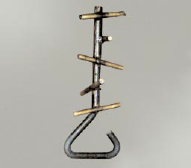
Figure 3.7.7. Heavy duty metal anchor.
The most difficult area in which to control thermal expansion is around the burner pipe where the steel shell, metal anchors, and refractory lining expand and shrink at differ-ent rates. Figure 3.7.7 illustrates a heavy duty anchor used in nose rings, tumblers and chains. Pre-engineered expansion joints do not work well because no prediction can be made as to where the lining is going to crack.
Elastic Modulus
The elastic modulus is one of the most important properties for kiln brick. Being a ratio between stress and strain, it determines how elas-tic or inelastic a brick is under mechanical stress. Figure 3.7.8 exemplifies the consequences of severe mechanical stress on the lining. Since the kiln shell is not rigid, the lining must be able to absorb the ovality stress generated around tire areas. Another property that depends on the elastic modulus is the thermal spalling resistance of the product. Products with low elastic modulus resist thermal spalling and mechanical stress better than products with high elastic modulus. This important property is seldom displayed in commercial product data sheets.
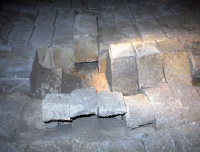
Figure 3.7.8. Brick damaged by mechanical stress.
Chemical Composition
Refractory chemistry is important because it helps determine if a given product is compatible with certain applications. Although the chemical composition alone is not a suitable criterion to define product usage, it is an important tool for predicting material compatibility, coatability, elastic behavior, and resistance to thermal shock.
Dimensional and Cosmetic Properties
Brick dimensions are critical to product installation and performance (see Figure 3.7.9). Chord tolerances should be kept within 0.6% from the nominal value, and brick taper, defined by the chord difference, should be kept within 1 mm from the nominal value. Taper deviations larger than 1 mm require the use of turning shims during installation. Depending on how large the deviation is, sometimes the brick cannot be installed even with the help of correction shims or mortar. The reason for such narrow tolerances is the cumulative effect of the deviation over the large number of bricks required per ring.
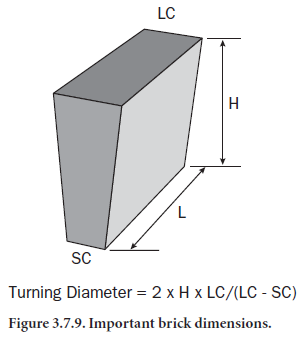
Brick measurement is a simple task; it should always be performed by the end user or its desig-nated inspector. All it requires is a tape measure for general dimensions and a caliper for chord and warpage measurement.
Warped brick is a serious manufacturing defect (see Figure 3.7.10). If the brick surfaces are concave or convex, the bricks only touch each other in a few spots, thus generating high mechanical stress in serv-ice. Sometimes the warpage is so severe that the bricks crack during the keying of the rings. The use of mortar during instal-lation can minimize the risks.
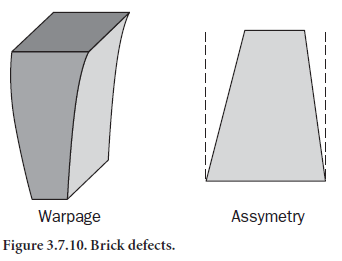
Brick asymmetry is a manufacturing defect caused during pressing. Asymmetric bricks should never be installed in the kiln, even with the help of shims or mortar.
All brick surfaces but the hot face must be free of imperfections, sintering, and sand grains. Any material attached to the brick surface creates tiny gaps in the lining. As the kiln rotates, these gaps accumulate and may lead to lining loosening and brick loss.
There are many more specific and generic properties of refractories such as density, porosity, modulus of rupture, cold crushing strength, thermal expansion, and refractoriness. However, from a strictly functional point of view, the ones previously described are the most important.
REFRACTORY WEAR
No matter how good or how suitable a refractory is, sooner or later it deteriorates and fails in serv-ice, forcing a kiln shutdown. Refractory wear increases with temperature and time. Some failures are progressive and the kiln can be shut down following a standard procedure before any damage is done to the shell. However, some failures are unpredictable, giving the operator almost no chance to protect the kiln shell. Most sudden brick losses bring permanent damage to the kiln shell, particularly if they coincide with power failures and heavy rain.
Modern kilns are equipped with shell temperature scanners that enable the kiln operator to see where the coating or the refractory lining is thin, before any damage is done to the shell. Scanners detect the so-called hot spots before they turn into damaging red spots. It is very important to instruct the kiln operators, through written procedures, on what to do during such emergencies.
Refractories fail at different times, in different kiln zones, and the failure mechanisms usually fall into one of three categories: 1) thermal
stress including overheating and thermal shock, 2) mechanical stress including compression, shearing, and pinch spalling, and 3) chemical attack including alkali bursting, redox, hydra-tion, and fluxing, as shown in Figure 3.7.11.
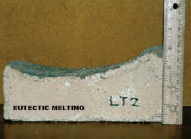
Figure 3.7.11. High-alumina brick destroyed by fluxing.
Most refractory failures are caused by a combination of two or more stress factors, such as a chemical reaction followed by brick melting, or lining densification followed by structural spalling.
Experience has demonstrated that the great majority of refractory failures are caused by poor kiln maintenance and unstable kiln operation. It is a well-recognized fact that stable kilns have refrac-tory performance superior to unstable kilns of the same type and size.
In the thermal stress category, lining overheating and sudden coating loss are the most common causes of brick failure. Overheating can be caused by many different factors such as feed starvation, excess fuel, kiln stoppages with the burner on, slow-ing the kiln down for long periods of time, defective burner pipe, and massive ash ring formation in the upper transition zone. Figures 3.7.12 and 3.7.13 show massive ring formation in the kiln. Lining overheating can be restricted to a given kiln zone or even to a few rows of brick within the zone. Sudden coating loss, for instance, submits the lining to damaging thermal shock.
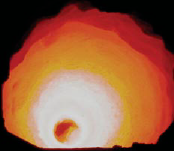
Figure 3.7.12. View inside the burning zone of a kiln. A ring can be seen in the background.
In the mechanical stress category, brick crush-ing is the most common problem (Figure 3.7.8). The main reasons for brick crushing are: 1) installation problems such as too many shims, gaps, and misalignment, 2) excessive shell ovality, 3) kiln misalignment (doglegs) as shown in Figure 3.7.14, and 4) improperly designed brick retainers.
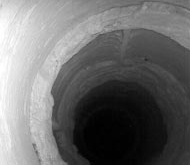
Figure 3.7.13. Spurrite ring formation in the magnesia-spinel products reacts with clinker calcining zone.
In the chemical attack category, brick reaction with clinker melt and alkali salts is the most common problem. The spinel phase in minerals to form low-melting compounds.
Dolomite reacts with sulphur and chlorine in a destructive way. Alumina bricks react with silica and potassium, forming compounds that burst the brick out. The intensity of the chemical attack increases with temperature, time, and proximity to the burning zone. The disposal of alternative fuels in cement kilns has intensified chemical attack to the lining in all kiln zones, including the preheater and cooler.
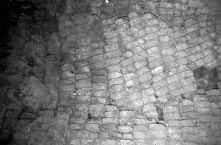
Figure 3.7.14 – Lining destroyed by kiln misalignment.
REFRACTORY APPLICATIONS
Choosing which product to use in each kiln area is perhaps one of the most difficult tasks refrac-tory suppliers and users face. The number of refractory products available to consumers today surpasses the hundreds. To add to the complexity of the problem, the type of fuels disposed of in cement kilns has also increased considerably, from agricultural wastes to plastic residues. The major problem in refractory selection is the lack of information about the kiln conditions.
Modern kiln systems are lined with refractories in four different areas: 1) preheater including inlet, feed shelf, precalciner, and cyclones, 2) rotary kiln, 3) hood including burner pipe, kiln door, and tertiary air intake, and 4) cooler including walls, bull nose, curbs, and tertiary air intake.
Preheaters
Preheaters are lined with brick, castables, and combinations of brick and castables. The best performances are obtained from brick linings because bricks have more uniform properties, are fired at high temperatures, and do not require the use of anchors. Bricks also yield more flexible linings than castables because of the larger number of joints in the brickwork. Perhaps the major negative in brick linings is that they require more time and skill to be properly installed.
Preheater linings consist of two layers of materials: a dense layer, also called the work layer, over a layer of insulating material such as insulating castable, firebrick, or fiberboard. The insulation must be efficient to minimize heat loss through radiation because the surface area of the preheater vessels and ducts is large. The combined lining thickness rarely exceeds 250 mm, with the dense layer usually taking from 50% to 75% of the total lining thickness.
The higher vessels and ducts in the preheater only require fireclay, low-alumina brick, or castable. Toward the kiln, where temperatures are higher, the lower stages 3, 4, and 5 work under high concentrations of chlorine, potassium, and sulfur. In these areas the refractory must be less perme-able and more resistant to alkali infiltration and attack. Care must be taken not to sacrifice chemi-cal resistance for refractoriness because the maximum temperature in this part of the kiln rarely exceeds 900°C.
Another important requirement for refractories in this area is their ability to repel buildups. As alkali sulfate and alkali chloride vapors progressively condense as salts on the lining surface, they reduce gas and solids flow, thus reducing preheater efficiency. If these buildups are not removed periodically through air or water blasting, they can completely block gas and material passage, thus forcing a kiln shutdown. Buildup removal with water requires high resistance to thermal shock from the lining. The material of choice for these areas is 60% or 70% alumina, low-cement castable, held in place by a combination of metal and ceramic anchors. If buildups are severe, zirconia or silicon carbide containing castables are much better alternatives since they do not hold buildups strongly. The use of silicon carbide in this application is not recommended if buildup removal is done with a water blast. Water promotes carbide oxidation at high temperatures.
Precalciners
For the precalciners, the riser duct, and the feed shelf, the same recommendations apply. In buildup areas the monolithic lining should not be gunned, shotcreted, or rammed, for maximum coating repellency.
The lining inside cyclones and the flash calciner is usually a combination of brick on the cylin-drical surfaces and castables on the conical sections, roof, vortex finders, and inlet chamber. The calciner lining must also resist reducing conditions created by incomplete fuel combustion.
Rotary Kilns
Modern rotary kilns can be safely lined with just two types of bricks: 1) high alumina in the calcin-ing and discharge zones, and 2) magnesia-spinel in the lower transition, upper transition, and burning zones. Many new kilns have been successfully commissioned with this simplified lining configuration, with good results. Some other kilns are lined with dolomite brick in the burning zone, magnesia-spinel brick in both transition zones, and high alumina in the calcining and discharge zones. The choice between dolomite and magnesia spinel in the burning zone depends upon a series of factors such as coating stability, type of fuels injected in the burning zone, insuf-flation of sodium carbonate or calcium chloride in the burning zone, and also the kiln run factor. The advantage of magnesia-spinel products over dolomite in the burning zone is their better resistance to structural spalling during coating loss or removal. The disadvantages are higher direct cost, lower coatability, and spinel reactivity with clinker melt.
The length and relative position of each kiln zone is a function of several factors such as kiln type, kiln dimensions, cooler type, fuel properties, burner design and position in the kiln, raw mix burn-ability, coating stability, and amount of liquid phase at different temperatures. Empirical rules such as defining zone length as a multiple or fraction of the kiln diameter should be avoided because they do not correlate with actual kiln conditions.
Kiln Hood
The next area of concern is the kiln hood, a transition chamber between the kiln and the clinker cooler. Temperatures in the hood are higher than those in the preheater, and potassium attack is a factor in refractory selection. Another factor of concern is the high concentration of abrasive clinker dust that could penetrate behind the refractory lining, pushing it in until it collapses. The most suitable material for hood walls is fireclay or low-alumina brick, followed by pre-cast, pre-fired shapes, and cast-in-place linings. On average, shotcrete or gunning mixes do not outlast the previous alternatives because they lack uniformity of properties.
Although bricks invariably outlast monolithic products in this application, brick installation is labor intensive and most plants avoid it. From a purely cost/benefit standpoint, brick lining is the best alternative. Pre-cast, pre-fired shapes made with low-cement castables usually last from 3 to 10 years without maintenance in cooler walls. However, when specifying shapes for this application, attention must be paid to all details during the design, manufacture, and installation of the shapes.
The back wall and the hood ceiling can be rammed with refractory plastic, gunned, sprayed, or formed, and cast. The two main wear factors in these areas are clinker dust, alkali attack, and anchor failure. In some kilns the back wall is equipped with air blasters to eliminate clinker buildup. The use of silicon carbide materials in this application could be advantageous.
Burner Pipe
The burner pipe is usually lined with 75 to 100 mm of plastic or castable, held in place by metal anchors. Anchor failure and differential expansion are the most frequent reasons for burner pipe failure as displayed in Figure 3.7.15. Consequently, it is important that the metal anchors are the floating type. Usually only the first 500 mm from the tip of the burner become damaged in service. This is the area that requires the most attention during material selection and installation
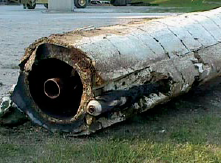
Figure 3.7.15. Damaged burner pipe lining.
Clinker Cooler
With modern, high-efficiency coolers, the secondary air temperature surpasses 1000°C, thus requir-ing more refractory products around the hood.Metal anchor failure under thermal stress became common, requiring stainless steel of higher grade and caliber. Ceramic anchors are required in the hottest areas. In some extreme cases, basic brick has been successfully used in the hood.
In the cooler, the three sidewalls before the bull nose can be lined in many different ways. A cost-effective alternative for this application is pre-cast blocks individually anchored through the cooler shell as shown in Figure 3.7.16. Anchoring the blocks inside the shell defeats the main advantage of this system: quick lining repair. The material of choice for the blocks is 70% alumina, low-cement castable. If cooler buildups (“snowmen”) are severe, then the blocks can be cast with silicon carbide to take advantage of its non-sticking properties. The air blasters are still required between the carbide blocks.
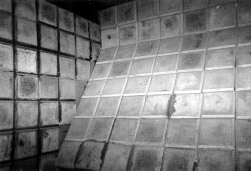
Figure 3.7.16. Clinker cooler walls lined with pre-cast shapes.
The bull nose is one of the most difficult areas for lining stability. Usually the wear mechanism is dust penetration behind the lining, followed by anchor overheating and shearing. The best lining alternative is interlocking pre-cast shapes anchored to a hollow box beam. Cold air is blown into the box to cool down the anchoring system. The refractory material must resist constant abrasion from hot clinker dust and frequent temperature changes.
At the grate level, refractory curbs are used to keep the clinker from eroding the walls. Curbs are usually formed and cast in place, requiring careful heat up because of their massive size. Here, too, pre-cast, pre-fired, high-alumina curbs make the best lining alternative. The use of 2% by weight steel fibers in this application is highly recommended. The fibers increase the tensile and flexural strength of the lining.
Walls in the cooler can be advantageously lined with inexpensive fireclay brick. Brick linings in the cooler, when properly anchored and mortared, should last no less than 10 years without repairs.
The cooler roof is best lined with plastic or a good quality shotcrete mix, anchored by a combina-tion of metal and ceramic anchors. Another cost effective alternative is to use pressed and fired shapes directly suspended from steel beams.
REFRACTORY MAINTENANCE
Refractory maintenance involves the demolition and removal of damaged linings, the installation of new linings, and, most importantly, the inspection and repair of existing linings.
In some cement plants the kiln is stopped for refractory replacement only when the lining fails. This corrective maintenance practice is dangerous to the equipment and involves high costs and risks such as:
• Permanent damage to the kiln shell – Distorted kiln shells are difficult to re-brick. Kiln misalignment caused by such deformations may induce frequent lining failures.
• Refractories ordered in emergency situations may not be the most suitable for the application, and their delivered price is usually higher than programmed orders.
• After a few shutdowns, the kiln will be lined with many different products that will in turn wear at different rates, causing other unexpected shutdowns.
• Every time the kiln is stopped for emergency repairs, the rest of the lining is subjected to addi-tional thermal and mechanical stresses.
• Emergency shutdowns do not allow maintenance crews to work in other critical parts of the kiln system such as rollers, seals, coal mill, pumps, clinker cooler, etc.
The preferred maintenance schedule is a well-programmed annual shutdown of at least three weeks, preferably during spring when the weather is warm enough for proper castable installation and curing. Moreover, maintenance costs tend to be lower during hot months than during winter.
Refractory maintenance is sometimes performed by house crews, sometimes sourced outside. Brick contractors are usually better trained in the job than home crews because they do it more often. Depending on the extension and complexity of the repair, house crews should not be involved in refractory maintenance. For instance, cement plants are usually not equipped to gun or shotcrete large volumes of monolithic materials, nor do they invest in brick demolition machines that stay idle most of the year.
When refractory maintenance is outsourced, then the plant must clearly define the scope of serv-ices and responsibilities, prior to opening the job for bids. By having a written understanding of what is to be expected from contractors, the plant can save considerable amounts of money and maintenance time, while obtaining the best lining quality. The list of requirements should cover, at a minimum, details such as what type of alloy is acceptable for metal anchors, what the welding procedures will be, who will collect testimonials, what the allowable number of bricking shims per ring is, etc. Any item or procedure that affects cost or quality must be properly defined.
One aspect of refractory maintenance commonly overlooked is the inspection and repair of preheater, hood, and cooler linings. Open joints and cracks must be sealed in order to prevent hot dust and gas penetration and destruction of the metal anchors.
REFRACTORY PROCUREMENT
Until recently, refractories were specified and purchased exclusively at plant level. This responsibil-ity was usually shared between the production manager and the plant manager.
With the consolidation of cement plants into fewer holding groups, the buying leverage of cement companies has increased considerably. For this reason many groups are centralizing their world-wide purchasing offices, and at the same time they are limiting the number of refractory suppliers to one or two per product line. The supplier selection criteria vary from group to group, but basi-cally it involves pricing, logistics, and payment terms. Only a minority of cement groups includes product quality, dimensional tolerances, amount of technical support, and post-service investiga-tion in their agreements.
Time has proven that there are benefits and risks associated with consolidated purchasing. The biggest benefit is volume leverage while the biggest risk is alienating the plants from the decision-making process.
The direct impact of refractories on cement manufacturing costs is less than 2% provided the prod-uct performs well.If the refractory lining fails prematurely, then cement manufacturing costs go up considerably. Unlike commodities such as grinding media, paper bags, lubricants, gypsum or coal, refractory failures cause kiln shutdown and sometimes permanent damage to the equipment. For these simple reasons refractories cannot be treated as commodities. Each refractory brand has its own set of physical and chemical properties that could make the difference between success and failure. These differences arise from raw materials and equipment used in brick manufacture.
One of the procedures in corporate purchasing is to have all plants in the group define which refractory products work for them, add up product tonnages, and then request bids from different suppliers. This approach does not necessarily reduce the number of suppliers, although it increases buying leverage. Another procedure is to restrict the total number of suppliers and have the plants work with a restricted line of products. The risks in this case far exceed the benefits: the limited line of products may not be sufficient to address individual differences between kilns such as raw mix, fuels, burner type, thermal loading, dust loading, and mechanical stress. A benefit common to both approaches is that the responsibility of carrying inventories is transferred to suppliers.
As a tool to force refractory suppliers to reduce their prices and costs, global purchasing is quite efficient. However, several refractory manufacturers closed their operations or discontinued entire product lines because their profits disappeared in a trade off for larger volumes. As the source of supply dwindles, market forces drive refractory prices up again, thus closing a cycle. Time and again, a free market without supplier exclusion and multiple products seems to be the best way to reduce refractory costs without halting investment in new product development.
INNOVATIONS AND FUTURE TRENDS
During the last decade cement kilns went through a technological revolution. Some of the major changes that affect refractory performance are:
• Increase in cooler efficiency, with a corresponding increase in secondary air temperatur
• Considerable increase in kiln slope
• Large increase in kiln specific loading
• Progressive reduction in kiln length
• Large increase in preheater and precalciner size
• Disposal of complex fuels and agro-industrial wastes in the kiln
• Higher demand for hard-to-burn clinkers such as low alkali and oil well
• Environmental limitations on disposal of used refractory
In response to the new challenges, the refractory industry developed new bricks and castables more resistant to chemical attack, thermal shock, and mechanical stress. Some of the major accomplish-ments in this area are:
• Magnesia-spinel products replacing magnesia-chrome
• Bricks with superior structural flexibility to absorb mechanical stress
• Bricks with reduced permeability to liquid and gas
• Bricks with better coatability
• Bricks with improved dimensional tolerances
• Castables with high flow ability and increased mechanical strength
• Shotcrete and gunning materials with very low rebound
• More efficient machines to remove and install refractories
• Instruments to accurately measure residual lining thickness
• Software to manage all aspects of refractory maintenance, allowing plants to exchange infor-mation on a worldwide basis
• Laser instruments to align the brickwork in the kiln
The present and future trends in refractories for cement kilns are toward monolithic products. As kilns become smaller and preheaters become larger, the brick business tends to shrink. Today the kiln represents only 25% of the total volume of refractories installed in a new cement plant. With future improvements in monolithic products and anchoring systems, that proportion will be further reduced. Bricks are still laid by hand, one by one, limiting the installation speed to no more than one meter per hour. Certain monolithic products can be shot in place at much higher speeds, using a reduced number of people.
Despite the progress made by the refractory industry so far, there are several areas in cement kilns that require additional product research and development. These include:
• More efficient buildup-repelling bricks and castables for preheater application
• Monolithic products for burning and transition zone application
• High-magnesia products with low modulus of elasticity
• High-magnesia products with lower thermal conductivity
• Dolomite products with higher resistance to hydration and spalling
• Chemically bonded, unfired basic and high-alumina brick
• Better lining systems for burner lances
• Explosion-proof monolithic products for fast firing.
REFERENCES
Aliprandi, G., Matériaux Réfractaires et Céramiques Techniques, Paris: Éditions Septima, 1989.
Alper, Allen M., High Temperature Oxides, Part I, Academic Press, New York, 1970.
Chapman, Robert P., Recommended Procedures For Mechanical Analysis of Rotary Kilns, Fuller Co., Bethlehem, Pennsylvania, 1985.
Ciullo, Peter A., Industrial Minerals and Their Uses, Westwood, Noyes Publications, New Jersey, 1996.
Lapoujade, P., and Le Mat, Y., Traité Pratique Sur L’Utilisation des Produits Réfractaires, Éditions H. Vial, Dourdan, France, 1986.
Mosci, R. A., Understanding Clinker Liquid Phase, RefrAmerica Technical Publication 01, Butler, Pennsylvania, April 1998.
Mosci R. A., Stop Kiln Shell Corrosion, RefrAmerica Technical Publication 02, Butler, Pennsylvania, November 2000.
Mosci, R. A., Eliminate Calcining Zone Rings, RefrAmerica Technical Publication 03, Butler, Pennsylvania, April 2001.
Mosci, R. A., Nose Ring Lining, RefrAmerica Technical Publication 04, Butler, Pennsylvania, November 2000.
Mosci, R. A., “Modular Lining for Clinker Coolers,” 2000 IEEE – IAS/PCA Technical Conference, Salt Lake City, Utah, May 7-12, 2000, pages 211-218.
Mosci, R. A., “The Power of Clinker Chemistry and Microscopy,” World Cement, Vol. 30, No. 8, Champlain, New York, August 1999, pages 55-61.
Mosci, R. A., “Ceramic Coatings Stop Kiln Shell Corrosion,” World Cement, Vol. 28, No. 12, Champlain, New York, December 1997, pages 28-30.
Mosci, R. A., Dolomite or Mag-Spinel in the Burning Zone, RefrAmerica Technical Publication 08, Butler, Pennsylvania, May 2001.
Mosci, R. A., What is the Optimum Brick Thickness for My Kiln?, RefrAmerica Technical Publication 09, Butler, Pennsylvania, May 2001.
Mosci, R. A., Silicon Carbide Versus Zirconia Against Buildups, RefrAmerica Technical Publication 10,Butler, Pennsylvania, May 2001.
Mosci, R. A., Brick Installation in Rotary Kilns, RefrAmerica, Butler, Pennsylvania, 1995.
Mosci, R. A., Maximum Kiln Shell Temperature, RefrAmerica Technical Publication 12, Butler, Pennsylvania, July 2002.
Seidel, G., Huckauf, H., Stark, J., Technologie des Ciments, Chaux, Plâtre, Éditions Septima, Paris, 1980.
Refractories Manual, 2nd Ed., American Foundrymen’s Society, Des Plaines, Illinois, 1989.
Schacht, Charles A., Refractory Linings, Marcel Dekker, Inc., New York, 1995.
